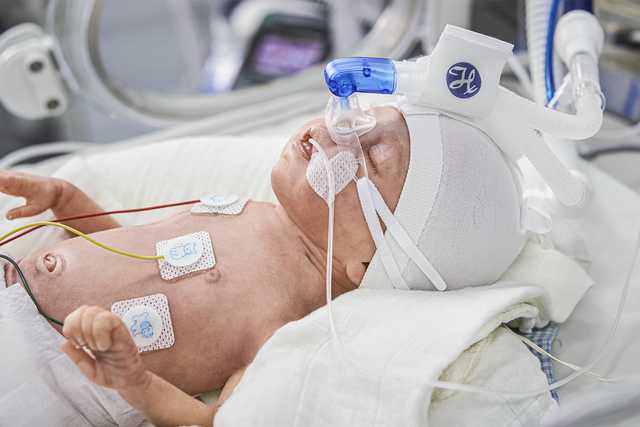

For your smallest patients. The neonatal option
The HAMILTON‑T1 with the neonatal option is an intelligent transport ventilator that provides ventilation therapy for your smallest and most fragile patients during transport. Thanks to its unique properties, the HAMILTON‑T1 performs like a fully featured NICU ventilator at the bedside ‑ even during transport.
Conventional and modern ventilation modes for neonates
Noninvasive ventilation integrated high flow nasal cannula therapy
CPR ventilation with integrated CO2 monitoring
Tidal volumes as low as 2 ml
Optimal synchronization using the neonatal proximal flow sensor
Specifically designed convenience sets including circuits, expiratory valve, and flow sensor
OSI Score (oxygen saturation index)
TI max (maximum inspiratory time)

Careful, not too much! Tidal volumes as low as 2 ml
With the neonatal option, the HAMILTON‑T1 provides tidal volumes as low as 2 ml for effective, safe, and lung‑protective ventilation for neonates (
Adaptive synchronization. Even with uncuffed tubes
Leaks may occur when ventilating neonates due to the use of uncuffed tubes. The IntelliTrig leak compensation function automatically adjusts the inspiratory and expiratory trigger sensitivity to leaks. This enables adaptive synchronization with the neonate’s breathing pattern.

Precision is vital. Proximal flow measurements
The proximal flow sensor and expiratory valve enable the precise measurement of pressure and flow directly at the airway opening, ensuring the required sensitivity and a quick response time.

Accuracy is the key. The neonatal expiratory valve
To meet the stringent requirements regarding the pressure accuracy at minimum volumes, we have developed an expiratory valve especially for neonatal ventilation.
This valve can compensate for even the most minute pressure differences and enables the neonate to breathe spontaneously in each phase of a controlled breath cycle.

Customer voices
To be able to use nCPAP with the HAMILTON‑T1 is a huge advantage for us. We no longer have to intubate certain babies just for transport.
Trisha Degoyer
Life Flight Neonatal RN
Intermountain Life Flight, Salt Lake City (UT), USA

Breathe easy. Neonatal ventilation modes
The HAMILTON‑T1 offers the option of noninvasive and invasive ventilation, with conventional and advanced ventilation modes for even the smallest patients.
The HAMILTON‑T1 is a state‑of‑the‑art ventilator offering a range of standard invasive ventilation modes for neonatal patients. These include pressure‑controlled modes (PCV+, PSIMV+, DuoPAP, APRV, SPONT) and volume‑targeted, adaptive pressure‑controlled modes (APVcmv / (S)CMV+, APVsimv / SIMV+, VS).
Your HAMILTON‑T1 can also be equipped with the high flow nasal cannula therapy option. With this enhancement, the HAMILTON‑T1 offers you a variety of therapy options in one device, including invasive and noninvasive ventilation, and high flow nasal cannula therapy. In just a few steps, you can change the interface and use the same device and breathing circuit to accommodate your patient’s needs.
Patient interventions during transport are not always possible. The nCPAP mode on the HAMILTON‑T1 is designed in such a way that you only need to set the desired CPAP pressure. The flow is subsequently adjusted automatically based on the patient condition and variation in leakage, which prevents unintended peak pressures and guarantees leak compensation. Flow adjustment occurs with a minimum of delay due to the highly sensitive, proximal pressure measurement.
In addition to the standard nCPAP mode, the HAMILTON‑T1 with the neonatal option also features the biphasic nCPAP‑PC (pressure‑controlled) mode. This mode allows you to set two pressure levels, as well as the rate and inspiratory time. The flow is also adjusted as needed in this mode. The modern pneumatic concept of the HAMILTON‑T1 enables the patient to breathe freely at any time on both pressure levels.

On land, at sea, and in the air. Approved for all types of transport
The HAMILTON‑T1 meets the transport standards EN 794‑3 and ISO 10651‑3 for emergency and transport ventilators, EN 1789 for ambulances and EN 13718‑1 as well as RTCA/DO‑160G for aircraft. It reliably accompanies your patients anywhere within or outside of the hospital, on the ground, at sea and in the air.
It's as easy as pie. Upgrade your HAMILTON‑T1 with the neonatal option
Book a free personal demonstration with one of our specialists to explore the benefits of our HAMILTON‑T1 with the neonatal option. They can guide you through the features and functionalities based on your specific needs.
Alternatively, you can schedule a callback, and our team will reach out to provide you with the necessary information and assistance.





